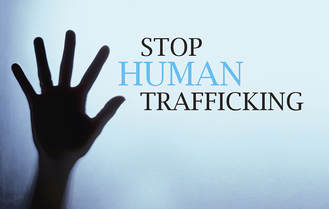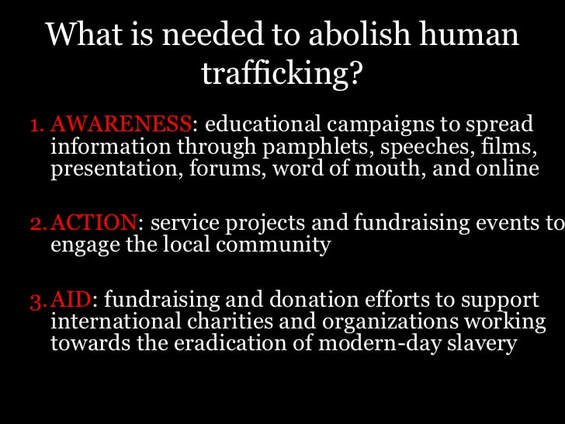Together we can....
Human trafficking is a form of modern-day slavery in which traffickers use force, fraud, or coercion to control victims for the purpose of engaging in commercial sex acts or labor services against his/her will.
Sex trafficking has been found in a wide variety of venues within the sex industry, including residential brothels, escort services, fake massage businesses, strip clubs, and street prostitution.
Labor trafficking has been found in diverse labor settings including, domestic work, small businesses, large farms, and factories.
Human trafficking is a form of modern-day slavery in which traffickers use force, fraud, or coercion to control victims for the purpose of engaging in commercial sex acts or labor services against his/her will.
Sex trafficking has been found in a wide variety of venues within the sex industry, including residential brothels, escort services, fake massage businesses, strip clubs, and street prostitution.
Labor trafficking has been found in diverse labor settings including, domestic work, small businesses, large farms, and factories.
Myths & Misconceptions
To effectively combat human trafficking, each of us needs to have a clear "lens" that helps us understand what human trafficking is. When this lens is clouded or biased by misconceptions about the definition of trafficking, our ability to respond to the crime is reduced. It is important to learn how to identify and break down commonly-held myths and misconceptions regarding human trafficking and the type of trafficking networks that exist in the United States.
Myth 1: Trafficked persons can only be foreign nationals or are only immigrants from other countries.
Reality: The federal definition of human trafficking includes both U.S. citizens and foreign nationals.
Both are protected under the federal trafficking statutes and have been since the TVPA of 2000. Human trafficking within the United States affects victims who are U.S. citizens, lawful permanent residents, visa holders, and undocumented workers.
Myth 2: Human trafficking is essentially a crime that must involve some form of travel, transportation, or movement across state or national borders.
Reality: Trafficking does not require transportation.
Although transportation may be involved as a control mechanism to keep victims in unfamiliar places, it is not a required element of the trafficking definition. Human trafficking is not synonymous with forced migration or smuggling, which involve border crossing.
Myth 3: Human trafficking is another term for human smuggling.
Reality: Smuggling is a crime against a country’s borders: human trafficking is a crime against a person.
Each are distinct federal crimes in the United States. While smuggling requires illegal border crossing, human trafficking involves commercial sex acts or labor or services that are induced through force, fraud, or coercion, regardless of whether or not transportation occurs.
Myth 4: There must be elements of physical restraint, physical force, or physical bondage when identifying a human trafficking situation.
Reality: Trafficking does not require physical restraint, bodily harm, or physical force.
Psychological means of control, such as threats, fraud, or abuse of the legal process, are sufficient elements of the crime. Unlike the previous federal involuntary servitude statutes (U.S.C. 1584), the new federal crimes created by the Trafficking Victims Protection Act (TVPA) of 2000 were intended to address “subtler” forms of coercion and to broaden previous standards that only considered bodily harm.
Myth 5: Victims of human trafficking will immediately ask for help or assistance and will self-identify as a victim of a crime.
Reality: Victims of human trafficking often do not immediately seek help or self-identify as victims of a crime due to a variety of factors, including lack of trust, self-blame, or specific instructions by the traffickers regarding how to behave when talking to law enforcement or social services. It is important to avoid making a snap judgment about who is or who is not a trafficking victim based on first encounters. Trust often takes time to develop. Continued trust-building and patient interviewing is often required to get to the whole story and uncover the full experience of what a victim has gone through.
Myth 6: Human trafficking victims always come from situations of poverty or from small rural villages.
Reality: Although poverty can be a factor in human trafficking because it is often an indicator of vulnerability, poverty alone is not a single causal factor or universal indicator of a human trafficking victim. Trafficking victims can come from a range of income levels, and many may come from families with higher socioeconomic status.
Myth 7: Sex trafficking is the only form of human trafficking.
Reality: The federal definition of human trafficking encompasses both sex trafficking and labor trafficking, and the crime can affect men and women, children and adults.
Myth 8: Human trafficking only occurs in illegal underground industries.
Reality: Trafficking can occur in legal and legitimate business settings as well as underground markets. Human trafficking has been reported in business markets such as restaurants, hotels, and manufacturing plants, as well as underground markets such as commercial sex in residential brothels and street based commercial sex.
Myth 9: If the trafficked person consented to be in their initial situation or was informed about what type of labor they would be doing or that commercial sex would be involved, then it cannot be human trafficking or against their will because they “knew better.
”Reality: Initial consent to commercial sex or a labor setting prior to acts of force, fraud, or coercion (or if the victim is a minor in a sex trafficking situation) is not relevant to the crime, nor is payment.
Myth 10: Foreign national trafficking victims are always undocumented immigrants or here in this country illegally.
Reality: Not all foreign national victims are undocumented. Foreign national trafficked persons can be in the United States through either legal or illegal means. Although some foreign national victims are undocumented, a significant percentage may have legitimate visas for various purposes.



